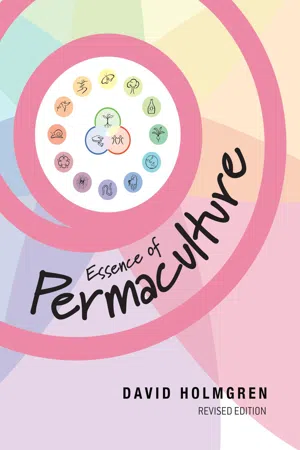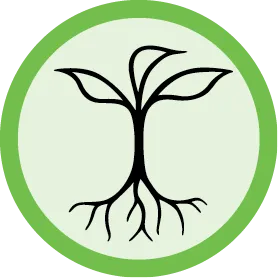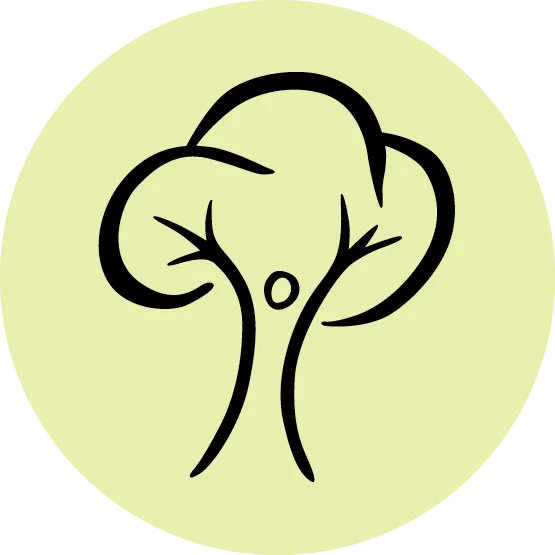
- English
- ePUB (mobile friendly)
- Available on iOS & Android
eBook - ePub
Essence of Permaculture
About this book
The Essence of Permaculture introduces the concept of permaculture and outlines the twelve permaculture principles. This booklet is both a 'taster' for the full length book by permaculture co-originator David Holmgren, and a standalone introduction to permaculture. It has been very popular with permaculture teachers to give to their students for introductory or further reading on the principles. It also contains some of David's reflections on the history and uptake of permaculture, and the future of the movement.
This 2020 revised edition has minor updates to reflect changes in society over the 15 years since it was originally published as well as further clarification of some of the principles.
Frequently asked questions
Yes, you can cancel anytime from the Subscription tab in your account settings on the Perlego website. Your subscription will stay active until the end of your current billing period. Learn how to cancel your subscription.
At the moment all of our mobile-responsive ePub books are available to download via the app. Most of our PDFs are also available to download and we're working on making the final remaining ones downloadable now. Learn more here.
Perlego offers two plans: Essential and Complete
- Essential is ideal for learners and professionals who enjoy exploring a wide range of subjects. Access the Essential Library with 800,000+ trusted titles and best-sellers across business, personal growth, and the humanities. Includes unlimited reading time and Standard Read Aloud voice.
- Complete: Perfect for advanced learners and researchers needing full, unrestricted access. Unlock 1.4M+ books across hundreds of subjects, including academic and specialized titles. The Complete Plan also includes advanced features like Premium Read Aloud and Research Assistant.
We are an online textbook subscription service, where you can get access to an entire online library for less than the price of a single book per month. With over 1 million books across 1000+ topics, we’ve got you covered! Learn more here.
Look out for the read-aloud symbol on your next book to see if you can listen to it. The read-aloud tool reads text aloud for you, highlighting the text as it is being read. You can pause it, speed it up and slow it down. Learn more here.
Yes! You can use the Perlego app on both iOS or Android devices to read anytime, anywhere — even offline. Perfect for commutes or when you’re on the go.
Please note we cannot support devices running on iOS 13 and Android 7 or earlier. Learn more about using the app.
Please note we cannot support devices running on iOS 13 and Android 7 or earlier. Learn more about using the app.
Yes, you can access Essence of Permaculture by David Holmgren in PDF and/or ePUB format, as well as other popular books in Education & Education General. We have over one million books available in our catalogue for you to explore.
Information
Permaculture Principles

The Value and Use of Principles
Permaculture principles are based on the idea that generalised principles can be derived from the study of the natural world and pre-industrial sustainable societies, and that they will be universally applicable to fast-track the development of regenerative use of land and resources, whether in a context of ecological and material abundance or one of deprivation.
The process of providing for people’s needs within ecological limits requires a cultural revolution. We have little time to achieve this revolution. Inevitably, a revolution is fraught with many confusions, false leads, risks and inefficiencies. Given this historical context, the idea of a simple set of guiding principles that have wide, even universal, application is attractive.
Permaculture principles are brief statements or slogans that can be remembered as a checklist when considering the inevitably complex options for designing ecological support systems. These principles are universal, but the methods that express them will vary greatly according to place and situation. They are also applicable to personal, economic, social and political reorganisation, as illustrated in the Permaculture Flower, although the range of strategies and techniques that reflect the principles in each domain is still evolving.
Ethics of Permaculture
Ethics act as constraints on survival instincts and other personal and social constructs of self-interest that tend to drive human behaviour. They are cultural mechanisms for more enlightened self-interest, a more inclusive view of who and what constitutes ‘us’, and a longer-term understanding of good and bad outcomes.
The greater the power of human civilisation (due to energy availability), and the greater the concentration and scale of power within society, the more critical ethics become in ensuring long-term cultural, and even biological, survival. This ecologically functional view of ethics makes them central in the development of a culture for energy descent.
Like design principles, ethical principles were not explicitly listed in early permaculture literature. Since the development of the Permaculture Design Course, ethics have generally been covered by three broad maxims or principles:



These statements of ethics were distilled from research into community ethics, as adopted by older religious cultures and modern co-operative groups. The third ethic, and even the second, can be seen as derived from the first.
The ethics continue to be taught and used as simple and relatively unquestioned ethical foundations for permaculture design within the movement and the wider ‘global nation’ of likeminded people. More broadly, these ethics can be seen as common to all traditional cultures that have connected people to land and nature throughout history.
This focus in permaculture on learning from indigenous cultures stems from these cultures having existed in relative balance with their environment and surviving for longer than any of our more recent experiments in civilisation.8
Of course, in our attempt to live an ethical life, we should not ignore the teachings of the great spiritual and philosophical traditions of literate civilisations, or the great thinkers of the scientific enlightenment and of current times. But in the long transition to a regenerative low-energy culture we need to consider, and attempt to understand, a broader canvas of values and concepts than those delivered to us by recent cultural history.9
Design Principles
The scientific foundation for permaculture design principles lies within the modern science of ecology, and more specifically within the branch of ecology called ‘systems ecology’. Other intellectual disciplines, especially landscape geography and ethno-biology, have contributed concepts that have been adapted to design principles.
Fundamentally, permaculture principles arise from a way of perceiving the world that is often described as ‘systems thinking’ and ‘design thinking’. Apart from the ecological energetics of Howard Odum, the influence of systems thinking in my development of permaculture and its design principles has not come through extensive study of the literature. Rather, it has been through an osmotic absorption of ideas in the cultural aether that strike a chord with my own experience in permaculture design. Further, I believe many of the abstract insights of systems thinking have more easily understood parallels in the stories and myths of indigenous cultures and, to a lesser extent, in the knowledge of all people still connected to land and nature.
Permaculture principles and ethics may be observed operating all around us. I argue that their absence, or apparent contradiction by modern industrial culture, does not invalidate their universal relevance to the descent into a low-energy future.
Most people will relate to and make use of permaculture as a toolkit of strategies, techniques and examples, however these are specific to each particular system’s scale, cultural and ecological context, and repertoire of skills and experience of those involved. To provide guidance in choosing and developing the useful applications, principles are needed to embody more general systems design concepts in language accessible to ordinary people.
I organise the diversity of permaculture thinking under twelve design principles. My set of design principles varies significantly from those used by many other permaculture authors and teachers. Some of this is simply a matter of emphasis and organisation; in a few cases it may indicate difference of substance. This is not surprising, given the new and still-emerging nature of permaculture.
The format of each of these principles is a positive action statement and an icon. The icon acts as a graphical reminder, encoding some fundamental aspect or example of the principle. A traditional proverb is also associated with each principle, emphasising the negative or cautionary aspect of the principle.
Each principle can be thought of as a door into the labyrinth of systems thinking. Any example used to illustrate one principle will also embody others, so the principles are simply thinking tools to assist us in identifying, designing and evolving design solutions.

Principle 1:
Observe and Interact
Observe and Interact
‘Beauty is in the eye of the beholder’
In nature animals survive and thrive by constantly observing (using different senses) and interacting with their environment. In traditional societies, children learned to become competent adults by observing and interacting in environments shaped by kin and culture.
In the modern world, formal education has replaced self-directed observation to a significant degree, and we have become separated from interactions, which are now mediated through technology and monetary transactions. In the process of gaining new technological skills and sophistication, we have lost much of our innate capacity to learn and look after ourselves, let alone design appropriate responses to emerging challenges.
Good design depends on a free and harmonious relationship between nature and people, in which careful observation and thoughtful interaction provide the design inspiration, repertoire and patterns. Design should not be generated in isolation, but through continuous and reciprocal interaction with the subject.
Permaculture designers use careful observation and thoughtful interaction to make effective use of human capabilities, reduce dependence on non-renewable energy, and consciously and continuously develop systems of land use and living that can sustain people through the era of energy descent.
‘Reading the Landscape’ to understand the pre-existing and often subtle but persistent patterns created by nature and ancestral use of the land, is the foundation of permaculture design. Designs should emerge from what already exists, rather than be an imposition on the land. With appropriate...
Table of contents
- What is Permaculture?
- Impediments to the Spread of Permaculture
- Fundamental Assumptions
- Permaculture Principles
- Conclusion
- Take the next steps